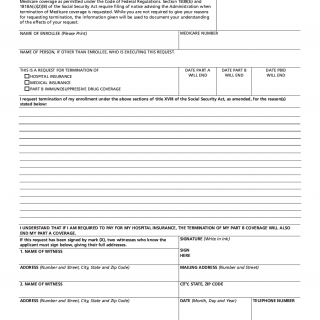CMS 1763. Request for Termination of Premium Hospital Insurance of Supplementary Medical Insurance
CMS 1763 is a form used to request the termination of premium hospital insurance or supplementary medical insurance. The main purpose of the form is to allow individuals to cancel their Medicare Part A or Part B coverage.
The form consists of several sections, including personal information such as the individual's name, address, and social security number. It also requires information about the type of coverage being terminated, the reason for the termination, and the effective date of the termination.
It is important to consider that individuals must have a valid reason for terminating their Medicare coverage, such as enrolling in a different health insurance plan or moving out of the country. Additionally, individuals must provide supporting documentation, such as proof of new insurance coverage or proof of residency in another country.
Application examples and use cases of the CMS 1763 form include canceling Medicare coverage due to enrolling in a new employer-sponsored health plan or canceling coverage due to moving out of the country.
Strengths of the form include its simplicity and effectiveness in allowing individuals to terminate their Medicare coverage. Weaknesses include the requirement for supporting documentation and the potential for confusion regarding the termination process.
Alternative forms to the CMS 1763 form include the CMS 1766 form for requesting a reconsideration of a Medicare premium determination and the CMS 855A form for Medicare enrollment of institutional providers.
The submission of the CMS 1763 form can affect the future healthcare coverage of the individual, as it terminates their Medicare Part A or Part B coverage. The form must be submitted to the local Social Security Administration office and is stored in their records system.
Overall, the CMS 1763 form is an essential document for individuals seeking to terminate their Medicare Part A or Part B coverage. It is important to carefully consider the requirements and supporting documentation needed when compiling the form, as well as alternative forms and their differences.

